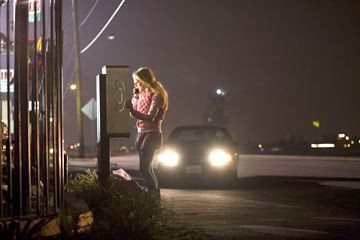Crime scenes

A dead girl lies in a grassy field. Her blood-soaked body has started to decompose. Who is she? How did she get there? Was the killing a crime of passion or opportunity? And who committed the heinous act?
On the plot-driven surface, these are the traditional “whodunit” queries that fuel The Dead Girl, the second feature by independent writer-director Karen Moncrieff (Blue Car). But as the story moves away from the corpse to the consciences of those who knew the young woman—or think they did—the film becomes a spiritual jigsaw puzzle, an effort to piece together the various stories that surrounded and led to the death.
Moncrieff breaks the tale down into five chapters, each focusing on a specific character who is influenced by, or responsible for, the fate of the dead girl. The first chapter, “The Stranger,” is a melodrama bordering on a horror story. It features the emotionally damaged woman (Toni Collette) who finds the body. She lives with her screeching invalid mother (Piper Laurie, paying homage to the similar role she played in Carrie), who holds some unspoken power over her daughter that involves a young boy. (Lost children are a recurring motif in the film.)
Once she has been identified in the media as the “local woman who found the dead body,” she finds herself being wooed by the muscular stockboy (Giovanni Ribisi) at the neighborhood grocery story, who is obsessed with serial killers. Their burgeoning relationship, though far from ideal, introduces her to a new kind of freedom.
“The Sister,” the second chapter, is more subtle and problematic. It concerns a young graduate student in forensics (Rose Byrne) whose life since childhood has been shadowed by the mysterious disappearance of her sister 15 years earlier. She is more than ready to move on, but her parents, and especially her mother (Mary Steenburgen), continue to thrive on the desperate hope that “missing posters” and Internet postings provide. When the grad student examines the dead body, she becomes convinced that it is her sister, no matter what the evidence suggests.
The third and most disturbing chapter is “The Wife,” starring Mary Beth Hurt as an angry middle-aged woman whose quiet husband often disappears for days at a time, leaving her to fend for herself and run his struggling storage-locker business. One day when he is gone, she runs across evidence suggesting that her husband is doing more than just visiting prostitutes during his sojourns. This leads to the film’s most potent moral dilemma, as the wife must weigh her own unhappiness and desire for revenge against her fear of being left alone. It is clear by this point that Moncrieff is especially concerned with the roles of women and their issues of loneliness, loss, dependency and regret.
The final two chapters in the film—“The Mother” and “The Dead Girl”—put the final pieces of the puzzle into place. The mother (Marcia Gay Harden, in a heartbreaking performance) drives hundreds of miles to claim the decaying body of her runaway daughter, only to discover the ugly truth behind the girl’s lifestyle through the eyes of the daughter’s roommate and lover, a bitter black prostitute (Kerry Washington). These revelations pave the way for the tale about the last hours of the girl’s life (she is played with frenetic energy by Brittany Murphy).
The Dead Girl is more than a tale of how a single life can affect many others. It is a commentary on the mountains of mutilated female corpses that populate television shows, and it implicitly raises the question: Why is such brutality a seemingly necessary part of the crime dramas that clog the airwaves?




